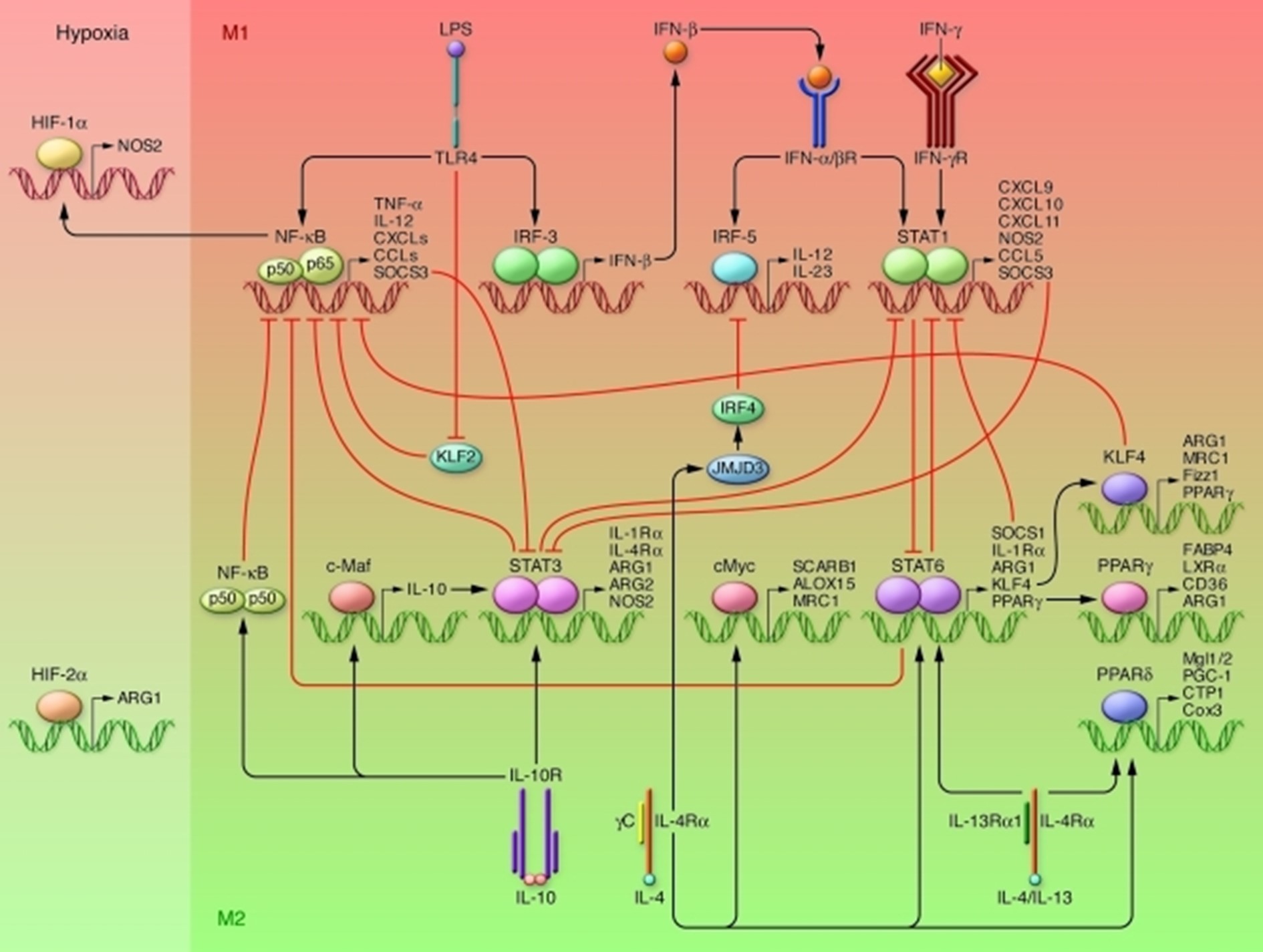Macrophages
Macrophages are key components of immune system which not only provide crucial roles in host defense and inflammation, but also regulate homeostasis via tissue remodeling and controlling metabolic functions. Although they are primarily known for their “phagocytosis” function, which is engulfing and digesting cellular debris and foreign substances, they can “polarize” into a spectrum of phenotypes and accept different roles in response to different triggers. The spectrum includes M1 (classic) and M2 (alternative) phenotypes on the two end tails and M2-like (M2a, M2b, M2c) and mixed type phenotypes in between (Figure 1).
.png)
In response to IFNs and Toll-like receptor engagement, macrophages polarize into M1 phenotype. This phenotype is characterized by microbicidal and tumoricidal activities and expression of high levels of proinflammatory cytokine. On the other hand, in response to IL-4/IL-13 signaling, macrophages polarize into M2 phenotype which is mostly involved in tissue remodeling and tumor progression. A nice demonstration of signaling molecules governing macrophage M1-M2 polarization is presented in (2) (Figure 2). Furthermore, in response to several triggers such as glucocorticoid hormones and molecules released from apoptotic cells, macrophages polarize into M2-Like phenotypes. M2-like phenotypes partially enjoy M2 phenotype characteristics. They negatively regulate proinflammatory cytokines and induce production of anti-inflammatory mediators. Moreover, they are involved in repair mechanisms, homeostasis, metabolic processes, and pathogenesis (2,3).
Macrophage diversity in phenotype, function and distribution is particularly evident in different stages of inflammation. Macrophages have major roles in inflammation: they secret cytokines and growth factors to modulate immune responses, take on the role of antigen presenting cells, and phagocytose (4–6). However, during inflammation, macrophage activation dynamically shifts. M1 macrophages have a vital role in initiating and sustaining of inflammation, whereas M2 macrophages are essential in the resolution of inflammation, maintaining homeostasis, and performing tissue remodeling. Furthermore, M2 phenotype depletion after the early stages of repair inhibits highly vascularized scarred tissues (2). Appropriate macrophage population phenotype shift is a crucial effect in inflammation as well as in (re)generation. In spite of well-recognized importance of this phenomenon, it is yet elusive if the fate shift at the population level is solely mediated through immigration and polarization of monocytes or if trans-differentiation of terminally differentiated macrophages do also account (7). To date, there have been evidences of M1 and M2-like cells reversing their phenotypes to some extent, in response to proper cytokine stimuli (2,3,8,9). Macrophage role in inflammation as well as its polarization has been of interest for mathematical modelers for many years (7,10,11). These models can pave the way for further understanding mechanisms governed by macrophages.

References
1. Weagel E, Smith C, Liu PG, Robison R, O’Neill K. Macrophage polarization and its role in cancer. J Clin Cell Immunol. 2015;6(4):338.
2. Sica A, Mantovani A. Macrophage plasticity and polarization: in vivo veritas. J Clin Invest. 2012;122(3):787–95.
3. Atri C, Guerfali FZ, Laouini D. Role of human macrophage polarization in inflammation during infectious diseases. Int J Mol Sci. 2018;19(6):1801.
4. Lee C-H, Choi EY. Macrophages and inflammation. J Rheum Dis. 2018;25(1):11–8.
5. Viola A, Munari F, Sánchez-Rodríguez R, Scolaro T, Castegna A. The metabolic signature of macrophage responses. Front Immunol. 2019;1462.
6. Fujiwara N, Kobayashi K. Macrophages in inflammation. Curr Drug Targets-Inflamm Allergy. 2005;4(3):281–6.
7. Nickaeen N, Ghaisari J, Heiner M, Moein S, Gheisari Y. Agent-based modeling and bifurcation analysis reveal mechanisms of macrophage polarization and phenotype pattern distribution. Sci Rep. 2019;9(1):1–14.
8. Saccani A, Schioppa T, Porta C, Biswas SK, Nebuloni M, Vago L, et al. p50 nuclear factor-κB overexpression in tumor-associated macrophages inhibits M1 inflammatory responses and antitumor resistance. Cancer Res. 2006;66(23):11432–40.
9. Edin S, Wikberg ML, Rutegård J, Oldenborg P-A, Palmqvist R. Phenotypic skewing of macrophages in vitro by secreted factors from colorectal cancer cells. PloS One. 2013;8(9):e74982.
10. Nyman E, Lindh M, Lövfors W, Simonsson C, Persson A, Eklund D, et al. Mechanisms of a Sustained Anti-inflammatory Drug Response in Alveolar Macrophages Unraveled with Mathematical Modeling. CPT Pharmacomet Syst Pharmacol. 2020;9(12):707–17.
11. Jansen JE, Gaffney EA, Wagg J, Coles MC. Combining mathematical models with experimentation to drive novel mechanistic insights into macrophage function. Front Immunol. 2019;1283.
Collaborations
- Markus Fridén, AstraZeneca.
- Daniel Eklund, Örebro University.
- Alexander Persson, Örebro University.
